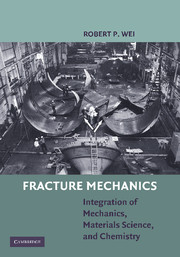Book contents
- Frontmatter
- Contents
- Preface
- Acknowledgments
- 1 Introduction
- 2 Physical Basis of Fracture Mechanics
- 3 Stress Analysis of Cracks
- 4 Experimental Determination of Fracture Toughness
- 5 Fracture Considerations for Design (Safety)
- 6 Subcritical Crack Growth: Creep-Controlled Crack Growth
- 7 Subcritical Crack Growth: Stress Corrosion Cracking and Fatigue Crack Growth (Phenomenology)
- 8 Subcritical Crack Growth: Environmentally Enhanced Crack Growth under Sustained Loads (or Stress Corrosion Cracking)
- 9 Subcritical Crack Growth: Environmentally Assisted Fatigue Crack Growth (or Corrosion Fatigue)
- 10 Science-Based Probability Modeling and Life Cycle Engineering and Management
- APPENDIX: Publications by R. P. Wei and Colleagues
- References
1 - Introduction
Published online by Cambridge University Press: 05 June 2012
- Frontmatter
- Contents
- Preface
- Acknowledgments
- 1 Introduction
- 2 Physical Basis of Fracture Mechanics
- 3 Stress Analysis of Cracks
- 4 Experimental Determination of Fracture Toughness
- 5 Fracture Considerations for Design (Safety)
- 6 Subcritical Crack Growth: Creep-Controlled Crack Growth
- 7 Subcritical Crack Growth: Stress Corrosion Cracking and Fatigue Crack Growth (Phenomenology)
- 8 Subcritical Crack Growth: Environmentally Enhanced Crack Growth under Sustained Loads (or Stress Corrosion Cracking)
- 9 Subcritical Crack Growth: Environmentally Assisted Fatigue Crack Growth (or Corrosion Fatigue)
- 10 Science-Based Probability Modeling and Life Cycle Engineering and Management
- APPENDIX: Publications by R. P. Wei and Colleagues
- References
Summary
Fracture mechanics, or the mechanics of fracture, is a branch of engineering science that addresses the problem of the integrity and durability of materials or structural members containing cracks or cracklike defects. The presence of cracks may be real, having been introduced through the manufacturing processes or during service. On the other hand, their presence may have to be assumed because limitations in the sensitivity of nondestructive inspection procedures preclude full assurance of their absence. A perspective view of fracture mechanics can be gained from the following questions:
How much load will it carry, with and without cracks? (a question of structural safety and integrity).
How long will it last, with and without cracks? Alternatively, how much longer will it last? (a concern for durability).
Are you sure? (the important issue of reliability).
How sure? (confidence level).
The corollary questions are as follows, and will not be addressed here:
How much will it cost? To buy? (capital or acquisition cost); to run? (operational cost); to get rid of? (disposal/recycling cost)
Optimize capital (acquisition) costs?
Optimize overall (life cycle) cost?
These questions appear to be simple, but are in fact profound and difficult to answer. Fracture mechanics attempts to address (or provides the framework for addressing) these questions, where the presence of a crack or cracklike defects is presumed.
- Type
- Chapter
- Information
- Fracture MechanicsIntegration of Mechanics, Materials Science and Chemistry, pp. 1 - 8Publisher: Cambridge University PressPrint publication year: 2010



